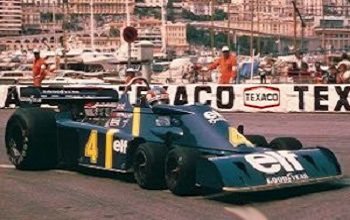The Tyrrell P34 was the boldest car seen on Formula One grids during the 1970s. The idea of six wheels came from Derek Gardner, Tyrrell’s chief designer, who calculated in 1974 that four small wheels at the front would hugely reduce a Formula One car’s fontal area.

Tyrrell P34 1976
- YEAR REVEALED 1976
- PLACE OF ORIGIN Ockham, Surrey, UK
- HISTORICAL STATUS Formula One racing car
- ENGINE V8-cylinder, 183ci (2,993cc)
- MAXIMUM POWER 485bhp
- LAYOUT mid-mounted engine driving the rear wheels
- BODYWORK single-seater racer
- TOP SPEED 186mph (299kph)
- NUMBER BUILT seven
Cutting aerodynamic drag would make the car faster, yet maintain the same surface-grip of two large wheels. For the P34, he chose 10in (25cm) diameter wheels, with crossply tires specially made by Goodyear.
All four wheels were steered and were fitted with miniature disc brakes. The car caused a storm when unveiled to the press in 1975, and made its public debut in the 1976 Spanish Grand Prix in the characteristic blue Elf oil livery.
The P34 showed great promise, especially when Jody Scheckter won the 1976 Swedish Grand Prix driving a P34, and his team-mate Patrick Depailler brought his example home second. Unfortunately, that was the pinnacle of success; this radical racer was dogged by braking and aerodynamics problems, and Goodyear had insufficient test facilities to develop the P34’s tiny tires to keep abreast of the latest rubber technology.
The P34 saw no further wins, although it often finished second. It was campaigned throughout the 1977 season, constantly modified but progressively less competitive. To Derek Gardner’s disappointment, the car was then retired as Tyrrell concentrated on the conventional 008 four-wheeler. Present Formula One regulations restrict cars to a four-wheeled layout only.